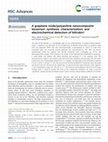Papers by Hamidreza Sayadi

Results in Chemistry, 2024
Nicotine, a component of tobacco smoke, is a neurotoxin. It exerts its effects by stimulating nic... more Nicotine, a component of tobacco smoke, is a neurotoxin. It exerts its effects by stimulating nicotine-containing acetylcholine receptors. Nicotine, one of over 4,700 components in tobacco smoke, was previously used as an insecticide in agriculture. Although the use of nicotine in agriculture has been banned in many countries, nicotine poisoning due to accidental or intentional ingestion of nicotine products remains a problem for smoking workers as well as children and adults. Understanding the mechanisms of nicotine poisoning is important for both prevention and treatment, as well as for appropriate regulatory approaches. We study the pharmacological properties of nicotine and the cellular mechanisms underlying acute and persistent nicotine addiction that appear to be related to the central and peripheral nervous systems. The electrochemical properties of nicotine were studied using a glassy carbon-chitosan/multiwalled carbon nanotubes-COOH electrode. Nicotine-COOH via chitosan/multiwalled carbon nanotubes was irreversibly reduced in the presence of oxygen and nitrogen gas. Oxidation signals at lower potentials and higher currents were obtained for nicotine via the modified electrode compared to the glassy carbon electrode. This condition proliferated in the presence of oxygen gas, suggesting that nanotubes, including carbon nanotubes, facilitate electron transfer and form the basis for electrocatalytic nicotine applications. Under optimal conditions, cyclic voltammetry (CV) shows oxidation of nicotine in the presence of oxygen at 0.74 V and nitrogen at 0.81 V in phosphate buffer solution at pH = 7.4. Linear calibration curves range from 0.1 to 200 μM for oxygen and 0.05 to 200 μM for nitrogen conditions, both with R2 = 0.99, and detection limits of 7.1 for oxygen and 9.2 nM for nitrogen.

Results in Chemistry, 2024
In this study, gold (Au), nanoclusters (NC) and heterogeneous titanium dioxide (TiO2) were succes... more In this study, gold (Au), nanoclusters (NC) and heterogeneous titanium dioxide (TiO2) were successfully synthesized
by low-temperature photoelectron spectroscopy. The chemical structure of Au-TiO2 was characterized
by XRD, EDX, XPS and HR-TEM. Optical properties were evaluated using PL and UV–Vis, and electrical properties
were evaluated using CV, CP, UPS and EIS parameters. The results showed that Au nanocluster (NCs) were
converted into Au nanoparticles (NPs) during high sunlight, and the transfer mechanism was examined. In
addition, the produced nanoparticles can form a Schottky barrier with TiO2, which affects the band structure.
Moreover, the simultaneous synthesis of nanoparticles and nanoclusters adds an extra dimension to the understanding
of the photoelectronic behavior of structured photoelectrodes. Moreover, this research shows that good
control of the photography process can result in more photos. This improvement is related to several factors,
including the plasmonic field and coupling line bending.

Results in Chemistry, 2024
We introduce silver-copper nanoparticles incorporated into polyaniline (PANI) nanotubes using a s... more We introduce silver-copper nanoparticles incorporated into polyaniline (PANI) nanotubes using a straightforward and efficient reduction process. In this regard, PANI nanotubes with amine groups were fabricated through oxidation polymerization, followed by the attachment of Ag and Cu precursors to enable the synthesis of Ag-Cu bimetallic nanoparticles (NPs) on the pre-formed PANI nanotubes with the use of hydrazine as a reducing agent. The structural characterization of the synthesized NPs was investigated by UV-Vis spectrophotometer (UV-Vis), Dark-field emission, (EDX), X-ray diffraction (XRD) and field emission (FESEM), while the electrochemical properties were estimated by (CV) and differential pulse voltammetry (DPV). The findings indicated that the Ag-Cu NPs were present in the nanoscale range, well-dispersed, and attached to the surface of PANI nanotubes. Electrochemical investigations revealed that the Ag-Cu@PANI nanotube electrode demonstrated efficient electrooxidation of dopamine and hydroquinone without any interfering reactions, suggesting its potential use as an electrochemical biosensor for simultaneous detection of dopamine and hydroquinone. The proposed NPs-based biosensor was connected to concurrently identify dopamine and hydroquinone, illustrating moo distinguish Confinements of 0.46 µM for dopamine and 0.23 mM for hydroquinone, separately. Additionally, the manufactured sensor identified on a wide direct run the dopamine (5-25 µM), and hydroquinone (0.5-2.5 mM). Alongside these promising comes about, the Ag-Cu@PANI nanotube actualized great solidness and reproducibility, making it a favorable stage for electrochemical biosensing of dopamine and hydroquinone.

Results in Chemistry, 2024
Biogas is obtained from the breakdown of biomass by microorganisms and bacteria in the absence of... more Biogas is obtained from the breakdown of biomass by microorganisms and bacteria in the absence of oxygen.
Biogas is considered a renewable source of energy, similar to solar energy and wind energy. Biogas can be
produced from biomass or bio-waste; thus, it is environmentally friendly. Biogas is obtained in a suspended
monoxide decomposition process by anaerobic bacteria or in a fermentation process of decomposable materials
such as agricultural manure, sewage, municipal waste, green waste (gardens and parks), plant material and
agricultural products. Biogas is a renewable natural energy source that leaves effective effects on nature and
industries. This gas is produced from the decomposition of organic materials, including animal manure, food
waste and sewage. Fertilizers and waste produce biogas through anaerobic digestion (ie without the presence of
oxygen). Biogas is a mixture of gases generated by decaying biodegradable material without the presence of
oxygen. Its main contents are 50–70 % of methane (CH4) by volume, 30–50 % of carbon dioxide (CO2), and
traces of other gases, like hydrogen sulfide (H2S) and water vapor (H2O). CO2, H2S, and water vapor content in
biogas may affect the performance and life of the energy conversion devices; consequently, their removal before
end-use is essential for improving the quality of biogas. This combination is an ideal option for making renewable
energy. The most important advantages of biogas (production of energy, reduction of the amount of discarded
waste, reduction of pathogens, conversion of waste containing organic matter into high quality fertilizer, protection
of vegetation, soil, water, increasing productivity in the field of livestock and agriculture) and It is also
one of the disadvantages of biogas (incomplete and small technologies, containing impurities, the effect of
temperature on biogas production, unsuitable for urban and dense areas, not affordable). For economical use of
biogas, the fermentation process can be carried out under controlled conditions in a relatively simple device
called a digestion reservoir. This review summarizes the current state-of-the-art and presents future perspectives
related to the anaerobic digestion process for biogas production. Moreover, a historical retrospective of biogas
sector from the early years of its development till its recent advancements give an outlook of the opportunities
that are opening up for process optimization.

RSC Advances, 2023
The level of free bilirubin is a considerable index for the characterization of jaundice-related ... more The level of free bilirubin is a considerable index for the characterization of jaundice-related diseases. Herein, a biosensor was fabricated via the immobilization of bilirubin oxidase (BOx) on graphene oxide (GO) and polyaniline (PANI) that were electrochemically co-precipitated on indium tin oxide (ITO) conductive glass. The structural enzyme electrode was characterized by FTIR, XRD, and Raman spectroscopy, while the spectral and thermal properties were investigated by UV-vis and thermogravimetric analysis (TGA). Owing to the activity of the fabricated BOx/GO@PANI/ITO biosensor, it could detect free bilirubin with good selectivity and sensitivity in a low response time. The electrochemical response was studied using electrochemical impedance spectroscopy (EIS) and cyclic voltammetry (CV). At polarization potential 0.2 V vs. Ag/AgCl, the fabricated sensor illustrated a response in only 2 s at 30°C and pH 7.5. The LOD and LOQ for the BOx/GO@PANI/ITO biosensor were calculated and found to be 0.15 nM and 2.8 nM, respectively. The electrochemical signal showed a linear response in the concentration range 0.01-250 mM. At 5°C, the biosensor demonstrated a half-time of 120 days, through which it could be utilized 100 times at this temperature conditions. By using a common colorimetric method, the data on bilirubin levels in serum showed a determination coefficient (R 2) of 0.97.
Carbon Letters, 2022
Nonporous materials have nano-sized pores. High specific surface area and size and shape selectiv... more Nonporous materials have nano-sized pores. High specific surface area and size and shape selectivity (size and shape Selectivity)
are the most important features of these materials that have led to their widespread use in various industries, such as
catalysts, water treatment and separation of pollutants. The development of properties and applications of these materials
depends on the fabrication of nanoporous materials with optimal and controlled structures. In this paper, porous nanostructures
and supermolecular chemistry are introduced in detail. Then, a number of common nanoporous materials, such as
activated carbon, metal–organic frameworks and zeolites, then various types of mineral and organic nanoporous materials
as well as methods of synthesis, characterization and applications of these materials will be studied in detail.

Applied Physics A, 2022
There is enormous interest in the use of graphene-based materials for energy storage. This articl... more There is enormous interest in the use of graphene-based materials for energy storage. This article discusses the progress
that has been accomplished in the development of chemical, electrochemical, and electrical energy storage systems using
graphene. We summarize the theoretical and experimental work on graphene-based hydrogen storage systems, lithium
batteries, and supercapacitors. Graphene could also be a two-dimensional (2D) sheet of carbon atoms in a very hexagonal
(honeycomb) configuration. The carbon atoms in graphene are bonded with the SP2 hybrid. Graphene is the most recent
member of the multidimensional graphite carbon family of materials. This family includes fullerene as zero-dimensional (0D)
nanomaterials, carbon nanotubes as one-dimensional (1D) nanomaterials, and graphite as a three-dimensional (3D) material.
The term graphene was first coined in 1986 to form the word graphite and a suffix (s) per polycyclic aromatic hydrocarbons.
Additionally, to monolayer and bilayer graphene, graphene layers from 3 to 10 layers are called few-layer graphene and
between 10 and 30 layers are called multiplayer graphene, thick graphene, or nanocrystals. Graphene is typically expected
to contain only one layer, but there is considerable interest in researching bilayer and low-layer graphene. There are several
methods for producing graphene, each with its own advantages and disadvantages. Graphene-based materials have great
potential to be employed in supercapacitors due to their unique two-dimensional structure and inherent physical properties
like excellent electrical conductivity and large area. This text summarizes recent developments within the sector of supercapacitors,
including double-layer capacitors and quasi-capacitors. The pros and cons of using them in supercapacitors are
discussed. Compared to traditional electrodes, graphene-based materials show some new properties and mechanisms within
the method of energy storage and release. During this paper, we briefly describe carbon structures, particularly graphene,
and also the history of graphene discovery, and briefly describe the synthesis methods, properties, characterization methods,
and applications of graphene.
Photoresponse performance of Au (nanocluster and n by Hamidreza Sayadi








Uploads
Papers by Hamidreza Sayadi
by low-temperature photoelectron spectroscopy. The chemical structure of Au-TiO2 was characterized
by XRD, EDX, XPS and HR-TEM. Optical properties were evaluated using PL and UV–Vis, and electrical properties
were evaluated using CV, CP, UPS and EIS parameters. The results showed that Au nanocluster (NCs) were
converted into Au nanoparticles (NPs) during high sunlight, and the transfer mechanism was examined. In
addition, the produced nanoparticles can form a Schottky barrier with TiO2, which affects the band structure.
Moreover, the simultaneous synthesis of nanoparticles and nanoclusters adds an extra dimension to the understanding
of the photoelectronic behavior of structured photoelectrodes. Moreover, this research shows that good
control of the photography process can result in more photos. This improvement is related to several factors,
including the plasmonic field and coupling line bending.
Biogas is considered a renewable source of energy, similar to solar energy and wind energy. Biogas can be
produced from biomass or bio-waste; thus, it is environmentally friendly. Biogas is obtained in a suspended
monoxide decomposition process by anaerobic bacteria or in a fermentation process of decomposable materials
such as agricultural manure, sewage, municipal waste, green waste (gardens and parks), plant material and
agricultural products. Biogas is a renewable natural energy source that leaves effective effects on nature and
industries. This gas is produced from the decomposition of organic materials, including animal manure, food
waste and sewage. Fertilizers and waste produce biogas through anaerobic digestion (ie without the presence of
oxygen). Biogas is a mixture of gases generated by decaying biodegradable material without the presence of
oxygen. Its main contents are 50–70 % of methane (CH4) by volume, 30–50 % of carbon dioxide (CO2), and
traces of other gases, like hydrogen sulfide (H2S) and water vapor (H2O). CO2, H2S, and water vapor content in
biogas may affect the performance and life of the energy conversion devices; consequently, their removal before
end-use is essential for improving the quality of biogas. This combination is an ideal option for making renewable
energy. The most important advantages of biogas (production of energy, reduction of the amount of discarded
waste, reduction of pathogens, conversion of waste containing organic matter into high quality fertilizer, protection
of vegetation, soil, water, increasing productivity in the field of livestock and agriculture) and It is also
one of the disadvantages of biogas (incomplete and small technologies, containing impurities, the effect of
temperature on biogas production, unsuitable for urban and dense areas, not affordable). For economical use of
biogas, the fermentation process can be carried out under controlled conditions in a relatively simple device
called a digestion reservoir. This review summarizes the current state-of-the-art and presents future perspectives
related to the anaerobic digestion process for biogas production. Moreover, a historical retrospective of biogas
sector from the early years of its development till its recent advancements give an outlook of the opportunities
that are opening up for process optimization.
are the most important features of these materials that have led to their widespread use in various industries, such as
catalysts, water treatment and separation of pollutants. The development of properties and applications of these materials
depends on the fabrication of nanoporous materials with optimal and controlled structures. In this paper, porous nanostructures
and supermolecular chemistry are introduced in detail. Then, a number of common nanoporous materials, such as
activated carbon, metal–organic frameworks and zeolites, then various types of mineral and organic nanoporous materials
as well as methods of synthesis, characterization and applications of these materials will be studied in detail.
that has been accomplished in the development of chemical, electrochemical, and electrical energy storage systems using
graphene. We summarize the theoretical and experimental work on graphene-based hydrogen storage systems, lithium
batteries, and supercapacitors. Graphene could also be a two-dimensional (2D) sheet of carbon atoms in a very hexagonal
(honeycomb) configuration. The carbon atoms in graphene are bonded with the SP2 hybrid. Graphene is the most recent
member of the multidimensional graphite carbon family of materials. This family includes fullerene as zero-dimensional (0D)
nanomaterials, carbon nanotubes as one-dimensional (1D) nanomaterials, and graphite as a three-dimensional (3D) material.
The term graphene was first coined in 1986 to form the word graphite and a suffix (s) per polycyclic aromatic hydrocarbons.
Additionally, to monolayer and bilayer graphene, graphene layers from 3 to 10 layers are called few-layer graphene and
between 10 and 30 layers are called multiplayer graphene, thick graphene, or nanocrystals. Graphene is typically expected
to contain only one layer, but there is considerable interest in researching bilayer and low-layer graphene. There are several
methods for producing graphene, each with its own advantages and disadvantages. Graphene-based materials have great
potential to be employed in supercapacitors due to their unique two-dimensional structure and inherent physical properties
like excellent electrical conductivity and large area. This text summarizes recent developments within the sector of supercapacitors,
including double-layer capacitors and quasi-capacitors. The pros and cons of using them in supercapacitors are
discussed. Compared to traditional electrodes, graphene-based materials show some new properties and mechanisms within
the method of energy storage and release. During this paper, we briefly describe carbon structures, particularly graphene,
and also the history of graphene discovery, and briefly describe the synthesis methods, properties, characterization methods,
and applications of graphene.
Photoresponse performance of Au (nanocluster and n by Hamidreza Sayadi
by low-temperature photoelectron spectroscopy. The chemical structure of Au-TiO2 was characterized
by XRD, EDX, XPS and HR-TEM. Optical properties were evaluated using PL and UV–Vis, and electrical properties
were evaluated using CV, CP, UPS and EIS parameters. The results showed that Au nanocluster (NCs) were
converted into Au nanoparticles (NPs) during high sunlight, and the transfer mechanism was examined. In
addition, the produced nanoparticles can form a Schottky barrier with TiO2, which affects the band structure.
Moreover, the simultaneous synthesis of nanoparticles and nanoclusters adds an extra dimension to the understanding
of the photoelectronic behavior of structured photoelectrodes. Moreover, this research shows that good
control of the photography process can result in more photos. This improvement is related to several factors,
including the plasmonic field and coupling line bending.
Biogas is considered a renewable source of energy, similar to solar energy and wind energy. Biogas can be
produced from biomass or bio-waste; thus, it is environmentally friendly. Biogas is obtained in a suspended
monoxide decomposition process by anaerobic bacteria or in a fermentation process of decomposable materials
such as agricultural manure, sewage, municipal waste, green waste (gardens and parks), plant material and
agricultural products. Biogas is a renewable natural energy source that leaves effective effects on nature and
industries. This gas is produced from the decomposition of organic materials, including animal manure, food
waste and sewage. Fertilizers and waste produce biogas through anaerobic digestion (ie without the presence of
oxygen). Biogas is a mixture of gases generated by decaying biodegradable material without the presence of
oxygen. Its main contents are 50–70 % of methane (CH4) by volume, 30–50 % of carbon dioxide (CO2), and
traces of other gases, like hydrogen sulfide (H2S) and water vapor (H2O). CO2, H2S, and water vapor content in
biogas may affect the performance and life of the energy conversion devices; consequently, their removal before
end-use is essential for improving the quality of biogas. This combination is an ideal option for making renewable
energy. The most important advantages of biogas (production of energy, reduction of the amount of discarded
waste, reduction of pathogens, conversion of waste containing organic matter into high quality fertilizer, protection
of vegetation, soil, water, increasing productivity in the field of livestock and agriculture) and It is also
one of the disadvantages of biogas (incomplete and small technologies, containing impurities, the effect of
temperature on biogas production, unsuitable for urban and dense areas, not affordable). For economical use of
biogas, the fermentation process can be carried out under controlled conditions in a relatively simple device
called a digestion reservoir. This review summarizes the current state-of-the-art and presents future perspectives
related to the anaerobic digestion process for biogas production. Moreover, a historical retrospective of biogas
sector from the early years of its development till its recent advancements give an outlook of the opportunities
that are opening up for process optimization.
are the most important features of these materials that have led to their widespread use in various industries, such as
catalysts, water treatment and separation of pollutants. The development of properties and applications of these materials
depends on the fabrication of nanoporous materials with optimal and controlled structures. In this paper, porous nanostructures
and supermolecular chemistry are introduced in detail. Then, a number of common nanoporous materials, such as
activated carbon, metal–organic frameworks and zeolites, then various types of mineral and organic nanoporous materials
as well as methods of synthesis, characterization and applications of these materials will be studied in detail.
that has been accomplished in the development of chemical, electrochemical, and electrical energy storage systems using
graphene. We summarize the theoretical and experimental work on graphene-based hydrogen storage systems, lithium
batteries, and supercapacitors. Graphene could also be a two-dimensional (2D) sheet of carbon atoms in a very hexagonal
(honeycomb) configuration. The carbon atoms in graphene are bonded with the SP2 hybrid. Graphene is the most recent
member of the multidimensional graphite carbon family of materials. This family includes fullerene as zero-dimensional (0D)
nanomaterials, carbon nanotubes as one-dimensional (1D) nanomaterials, and graphite as a three-dimensional (3D) material.
The term graphene was first coined in 1986 to form the word graphite and a suffix (s) per polycyclic aromatic hydrocarbons.
Additionally, to monolayer and bilayer graphene, graphene layers from 3 to 10 layers are called few-layer graphene and
between 10 and 30 layers are called multiplayer graphene, thick graphene, or nanocrystals. Graphene is typically expected
to contain only one layer, but there is considerable interest in researching bilayer and low-layer graphene. There are several
methods for producing graphene, each with its own advantages and disadvantages. Graphene-based materials have great
potential to be employed in supercapacitors due to their unique two-dimensional structure and inherent physical properties
like excellent electrical conductivity and large area. This text summarizes recent developments within the sector of supercapacitors,
including double-layer capacitors and quasi-capacitors. The pros and cons of using them in supercapacitors are
discussed. Compared to traditional electrodes, graphene-based materials show some new properties and mechanisms within
the method of energy storage and release. During this paper, we briefly describe carbon structures, particularly graphene,
and also the history of graphene discovery, and briefly describe the synthesis methods, properties, characterization methods,
and applications of graphene.